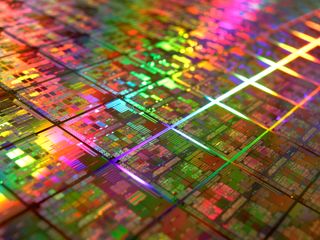How AMD is getting out of the rut
New Opteron quad-core bodes well for future desktop chips

The quad-core era has been tough for AMD. But with the launch of new 45nm Opteron CPUs today, the fight back has begun.
You can read our full review of the Opteron 2384. The short version is that in server trim, the new 45nm Shanghai architecture is not revolutionary. However, it is a big improvement over AMD's botched 65nm quad-core chips.
In fact, thanks to the combination of improved power efficiency and performance, AMD can make a pretty good argument for the new Opterons being the best server chips available at certain price points.
But does Shanghai have the makings of Core i7-bashing desktop processor? That is an extremely tall order. Intel's new chip is an absolute monster. But Shanghai looks like it should be good enough to at least give AMD a decent mid-range quad-core competitor.
AMD's upcoming 45nm quad-core desktop chips actually go under the codename Deneb. But they're pretty much identical to the Shanghai core found in the new Opterons launched today.
Big improvement expected
Now, the top Opteron 2384 chip launched today runs at 2.7GHz. Not exactly spectacular by desktop standards. But that processor has a modest 75 watt rating. We therefore expect AMD will hit at least 3GHz when 45nm Phenom desktop processors appear, probably in early January.
Get daily insight, inspiration and deals in your inbox
Get the hottest deals available in your inbox plus news, reviews, opinion, analysis and more from the TechRadar team.
That will hardly be enough to decimate Core i7. But it will be a big improvement over existing 65nm Phenoms which top out at 2.6GHz and suck up an awful lot of power in the process.
What's more, if the new 45nm process is as healthy as it appears, AMD should be able to crank out ever quicker models at a much faster rate than the rather pitiful trickle it managed with 65nm Phenoms.
Having said all that, let's not get carried away. Deneb will not be a game changer in the mould of AMD's own Radeon HD 4800 GPU. That graphics chip shocked Nvidia with its combination of efficiency, affordability and performance.
Instead, Deneb is more analogous to the Radeon HD 3800 – a successful die-shrink of a troubled architecture. But you have to start somewhere. If AMD's CPU engineers can follow a similar path that its graphics chip architects have carved out over the past year or so, all will be well.
In that context, the great hope is AMD's upcoming Bulldozer core, its first properly new processor architecture since the Athlon 64 of 2003. It's not due until 2010. But we've heard whispers on the wind it will pack even wider instruction issuing than Intel's four-issue Core processors.
If that turns out to be true, well, Intel could finally have a real fight on its hands.
Technology and cars. Increasingly the twain shall meet. Which is handy, because Jeremy (Twitter) is addicted to both. Long-time tech journalist, former editor of iCar magazine and incumbent car guru for T3 magazine, Jeremy reckons in-car technology is about to go thermonuclear. No, not exploding cars. That would be silly. And dangerous. But rather an explosive period of unprecedented innovation. Enjoy the ride.
Most Popular


